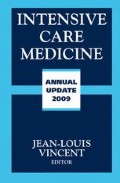Abstract
Tracheal intubation procedures are common, high risk events for critically ill children. Although tracheal intubation is infrequently performed by resident trainees, the Accreditation Committee for Graduate Medical Education (ACGME) in the United States mandates that pediatric residents gain tracheal intubation procedural competency during clinical rotations in the delivery room, neonatal ICU (NICU), and pediatric ICU (PICU) [1]. We will review current issues regarding tracheal intubation training and skill acquisition, as well as the effects of this training on patient outcomes.
Access this chapter
Tax calculation will be finalised at checkout
Purchases are for personal use only
Preview
Unable to display preview. Download preview PDF.
References
Gausche M, Lewis RJ, Stratton SJ, et al (2000) Effect of out-of-hospital pediatric endotracheal intubation on survival and neurological outcome: A controlled clinical trial. JAMA; 283: 783–790
Sagarin MJ, Chiang V, Sakles JC, et al (2002) Rapid sequence intubation for pediatric emergency airway management. Pediatr Emerg Care 18: 417–423
Easley RB, Segeleon JE, Haun SE, et al (2000) Prospective study of airway management of children requiring endotracheal intubation before admission to a pediatric intensive care unit. Crit Care Med 28: 2058–2063
Nishisaki A, Ferry S, Kalsi M, et al (2007) Who actually performs tracheal intubation in an academic Pediatric Intensive Care Unit? Crit Care Med 35 (Suppl):A128 (abst)
Orlowski JP, Ellis NG, Amin NP, Crumrine RS (1980) Complications of airway intrusion in 100 consecutive cases in a pediatric ICU. Crit Care Med 8: 324–331
Rivera R, Tibballs J (1992) Complications of endotracheal intubation and mechanical ventilation in infants and children. Crit Care Med 20: 193–199
O’Donnell CP, Kamlin CO, Davis PG, et al (2006) Endotracheal intubation attempts during neonatal resuscitation: Success rates, duration and adverse effects. Pediatrics 117: e16–e21
Falck AJ, Escobedo MB, Baillargeon JG, Villard LG, Gunkel JH (2003) Proficiency of pediatric residents in performing neonatal endotracheal intubation. Pediatrics 112: 1242–1247
Leone TA, Rich W, Finer NN (2005) Neonatal intubation: Success of pediatric trainees. J Pediatr 146: 638–641
Kattwinkel J (2000) The Textbook of Neonatal Resuscitation. 4th edition. American Academy of Pediatrics and American Heart Association, Elk Glove Village
Gaies MG, Landrigan CP, Hafler JP, et al (2007) Assessing procedural skills training in pediatric residency programs. Pediatrics 120: 715–722
Plummer JL, Owen H (2001) Learning endotracheal intubation in a clinical skills learning center: A quantitative study. Anesth Analg 93: 656–662
Owen H, Plummer JL (2002) Improving learning of a clinical skill: the first year’s experience of teaching endotracheal intubation in a clinical simulation facility. Med Educ 36: 635–642
Konrad C, Schüpfer G, Wietlisbach M, Gerber H (1998) Learning manual skills in anesthesiology: Is there a recommended number of cases for anesthetic procedures? Anesth Analg 86: 635–639
Kovacs G, Ackroyd-Stolarz S, Cain E, et al (2000) A randomized controlled trial on the effect of educational interventions in promoting airway management skill maintenance. Ann Emerg Med 36: 301–309
Nishisaki A, Scrattish L, Boulet J, et al (2008) Effect of recent refresher training on in situ simulated pediatric tracheal intubation psychomotor skill performance. In Henriksen K, Battles JB, Keyes MA, Grady ML (eds) Advances in Patient Safety: New Directions and Alternative Approaches, Vol. 3. Performance and Tools. Agency for Healthcare Research and Quality, Rockville
Niles D, Sutton R, Donoghue A, et al (2007) “Rolling Refreshers”: A novel approach to maintain CPR psychomotor skill competence. Pediatr Crit Care Med 8 (Suppl): A243 (abst)
Hunt EA, Shilkofski NA, Stavroudis TA, Nelson KL (2007) Simulation: translation to improved team performance. Anesthesiol Clin 25: 301–319
Seymour NE, Gallagher AG, Roman SA, et al (2002) Virtual reality training improves operating room performance. Ann Surg 236: 458–464
Grantcharov TP, Kristiansen VB, Bendix J, et al (2004) Randomized clinical trial of virtual reality simulation for laparoscopic skills training. Br J Surg 91: 146–150
Dawson DL (2006) Training in carotid artery stenting: do carotid simulation systems really help? Vascular 14: 256–263
DeVita MA, Schaeffer J, Lutz J, Dongilli T, Wang H (2004) Improving medical crisis team performance. Crit Care Med 32 (Suppl 2):S61–65
Zirkle M, Blum R, Raemer DB, Healy G, Roberson DW (2005) Teaching emergency airway management using medical simulation: a pilot program. Laryngoscope 115: 495–500
Nishisaki A, Keren R, Nadkarni V (2007) Does simulation improve patient safety? Self-efficacy, competence, operational performance, and patient safety. Anesthesiol Clin 25: 225–236
Moorthy K, Munz Y, Adams S, et al (2006) Self-assessment of performance among surgical trainees during simulated procedures in a simulated operating theater. Am J Surg 192: 114–118
Mayo PH, Hackney JE, Mueck T, et al (2004) Achieving house staff competence in emergency airway management: results of a teaching program using a computerized patient simulator. Crit Care Med 32: 2422–2427
Overly FL, Sudikoff SN, Shapiro MJ (2007) High-fidelity medical simulation as an assessment tool for pediatric residents’ airway management skills. Pediatr Emerg Care 23: 11–15
Hall RE, Plant JR, Bands CJ, et al (2005) Human patient simulation is effective for teaching paramedic students endotracheal intubation. Acad Emerg Med 12: 850–855
Harden RM (2007) Learning outcomes as a tool to assess progression. Med Teach 29: 678–682
Nishisaki A, Donoghue A, Bishnoi R, et al (2007) Validation of an in situ ICU technical and behavioral simulation scoring tool: Just in Time Pediatric Airway Provider performance Scale. Crit Care Med 35 (Suppl):A122 (abst)
Author information
Authors and Affiliations
Editor information
Editors and Affiliations
Rights and permissions
Copyright information
© 2009 Springer-Verlag Berlin Heidelberg
About this paper
Cite this paper
Nishisaki, A., Nadkarni, V.M., Berg, R.A. (2009). Pediatric Advanced Airway Management Training for Non-anesthesia Residents. In: Vincent, JL. (eds) Intensive Care Medicine. Springer, New York, NY. https://doi.org/10.1007/978-0-387-92278-2_31
Download citation
DOI: https://doi.org/10.1007/978-0-387-92278-2_31
Publisher Name: Springer, New York, NY
Print ISBN: 978-0-387-92277-5
Online ISBN: 978-0-387-92278-2
eBook Packages: MedicineMedicine (R0)

